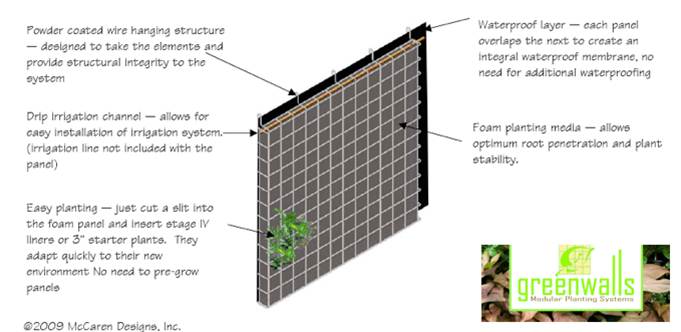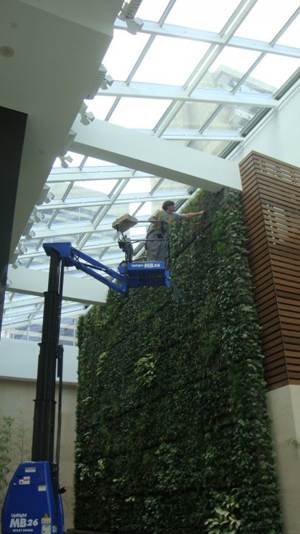

Where Green walls Work
Green walls are adaptable to almost any vertical surface. The single biggest factor when it comes to the success of a green wall is having properly designed systems to maintain it. When designing a green wall, look to successful commercial applications and to nature for the basic design of vertical planting systems.
Design Considerations
There are several important design and structural differences between ground-level garden design and vertical garden design. Here are a few special construction requirements and considerations when developing the vertical garden/green wall:
- Protection of the structural support system's integrity, and waterproofing protection of that system.
- Positive drainage throughout the system so that plantings at the bottom will have optimal growing conditions without becoming over saturated.
- A long-term, lightweight planting medium that isn't subject to deterioration through decomposition (normally, this is a synthetic product).
- Irrigation and fertilization for optimum plant growth and sustainability.
- Adaptation of the plantings to the environmental conditions.
- Provisions for maintenance.
The most important element in the construction of a green wall is protecting the integrity of the structural components that support the vertical garden. For this reason, there must be waterproofing of exceptional longevity to prevent damage and reduce the possibility of a long-term, expensive reconstruction. Think about these things:
Load-bearing capacity. You just can't hang a green wall on any old wall; they can weigh anywhere from 25 to 40 pounds per square foot once they're fully saturated with water. Consult with a structural engineer to verify the load-bearing capacity of your wall (or whatever structure will support the green wall).
Waterproofing. There are several types of waterproofing available; however, fluid-applied elastomeric materials offer excellent protection. The modular system is best protected by a powder-coated protection similar to the racks in a dishwasher. If funding permits, the structural members can be constructed of stainless steel vs. waterproofing the system.
Planting provisions. Like any planting, the success of the installation depends on providing the correct infrastructure on the surface of whatever the vertical garden will be built upon; therefore, it's imperative to take care in choosing and installing materials of the highest quality, and species conducive to the green wall environment. In an arid area, you should use plants that can withstand the dry conditions; in an interior green wall, you need to select plants that can take the lighting levels offered by the space.
Drainage requirements. The system can be designed as a closed drainage system or an open system. In closed drainage systems, the irrigation water is collected and recycled; however, this system needs to have a little water sent to the drain to control the build-up of soluble salts that are left over as the water evaporates. Failure to drain water from the system can result in damage to the green wall. The closed system is more ecological to operate, but it does have drawbacks. If any plant disease is introduced into the plantings, it's transmitted throughout the system by the use of recycled water. This drawback can be managed by a process of ultraviolet sanitation of the recycled water. In an open system, excess irrigation water is discharged into the building's drainage system. By using an open system, the build-up of salts in the planting medium, and the sanitation issues, is reduced significantly.
Excess irrigation water must be captured at the base of the green wall. Any time you have water free-flowing through the plantings, there's bound to be some dripping from the plantings that cannot be avoided. You must have an area at the base of a green wall that can become a wet surface.
Planting media. The critical criteria of a suitable planting media for green wall planting: It should be lightweight, it should have the ability to hold nutrients, and it should offer adequate moisture-holding capacity and the capability of developing a firm root zone (for plant stability)—but it must also drain easily. Additionally, if the system is to become an active green wall/bio-wall air-filtration system, the media must provide adequate air exchange.
Irrigation. The supply of moisture to the soil mass is critical to the survival of the green wall. Although it may sound like an elementary process, it's a rather complex operation. The supply of water, how it will be supplied, and some inherent problems with water types are all factors that need to be considered in the design process so that plantings can be successful and economical. The relatively thin, well-drained, soulless mixtures used in a green wall cannot provide the plantings with the subsurface water normally available to ground-level plantings. Care must be exercised to prevent the planting media from drying out and causing damage to the plant materials. Normally, a sensor-controlled drip irrigation system can manage the irrigation system using a minimum amount of water.
Source: http://www.buildings.com/Magazine/ArticleDetails/tabid/3413/ArticleID/6458/Default.aspx
|



